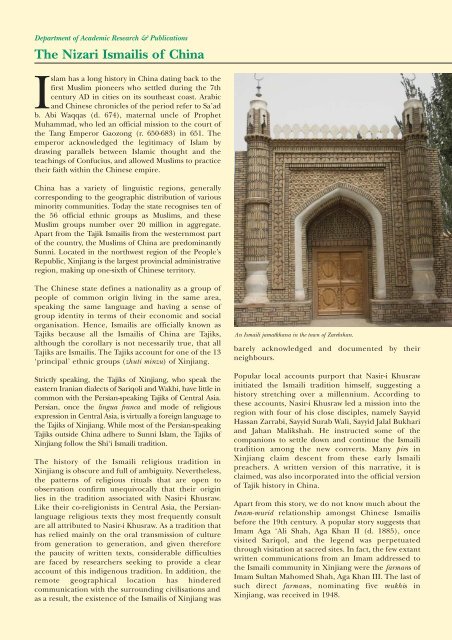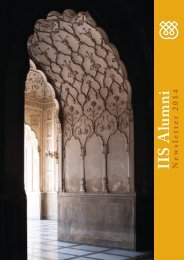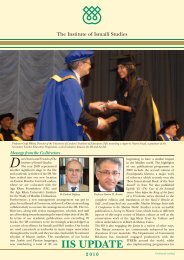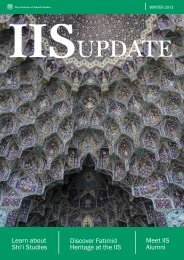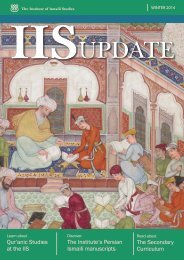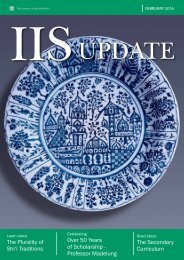iisupdate2011-12new
You also want an ePaper? Increase the reach of your titles
YUMPU automatically turns print PDFs into web optimized ePapers that Google loves.
Department of Academic Research & Publications<br />
The Nizari Ismailis of China<br />
Islam has a long history in China dating back to the<br />
first Muslim pioneers who settled during the 7th<br />
century AD in cities on its southeast coast. Arabic<br />
and Chinese chronicles of the period refer to Sa’ad<br />
b. Abi Waqqas (d. 674), maternal uncle of Prophet<br />
Muhammad, who led an official mission to the court of<br />
the Tang Emperor Gaozong (r. 650-683) in 651. The<br />
emperor acknowledged the legitimacy of Islam by<br />
drawing parallels between Islamic thought and the<br />
teachings of Confucius, and allowed Muslims to practice<br />
their faith within the Chinese empire.<br />
China has a variety of linguistic regions, generally<br />
corresponding to the geographic distribution of various<br />
minority communities. Today the state recognises ten of<br />
the 56 official ethnic groups as Muslims, and these<br />
Muslim groups number over 20 million in aggregate.<br />
Apart from the Tajik Ismailis from the westernmost part<br />
of the country, the Muslims of China are predominantly<br />
Sunni. Located in the northwest region of the People’s<br />
Republic, Xinjiang is the largest provincial administrative<br />
region, making up one-sixth of Chinese territory.<br />
The Chinese state defines a nationality as a group of<br />
people of common origin living in the same area,<br />
speaking the same language and having a sense of<br />
group identity in terms of their economic and social<br />
organisation. Hence, Ismailis are officially known as<br />
Tajiks because all the Ismailis of China are Tajiks,<br />
although the corollary is not necessarily true, that all<br />
Tajiks are Ismailis. The Tajiks account for one of the 13<br />
‘principal’ ethnic groups (zhuti minzu) of Xinjiang.<br />
Strictly speaking, the Tajiks of Xinjiang, who speak the<br />
eastern Iranian dialects of Sariqoli and Wakhi, have little in<br />
common with the Persian-speaking Tajiks of Central Asia.<br />
Persian, once the lingua franca and mode of religious<br />
expression in Central Asia, is virtually a foreign language to<br />
the Tajiks of Xinjiang. While most of the Persian-speaking<br />
Tajiks outside China adhere to Sunni Islam, the Tajiks of<br />
Xinjiang follow the Shi‘i Ismaili tradition.<br />
The history of the Ismaili religious tradition in<br />
Xinjiang is obscure and full of ambiguity. Nevertheless,<br />
the patterns of religious rituals that are open to<br />
observation confirm unequivocally that their origin<br />
lies in the tradition associated with Nasir-i Khusraw.<br />
Like their co-religionists in Central Asia, the Persianlanguage<br />
religious texts they most frequently consult<br />
are all attributed to Nasir-i Khusraw. As a tradition that<br />
has relied mainly on the oral transmission of culture<br />
from generation to generation, and given therefore<br />
the paucity of written texts, considerable difficulties<br />
are faced by researchers seeking to provide a clear<br />
account of this indigenous tradition. In addition, the<br />
remote geographical location has hindered<br />
communication with the surrounding civilisations and<br />
as a result, the existence of the Ismailis of Xinjiang was<br />
An Ismaili jamatkhana in the town of Zarebshan.<br />
barely acknowledged and documented by their<br />
neighbours.<br />
Popular local accounts purport that Nasir-i Khusraw<br />
initiated the Ismaili tradition himself, suggesting a<br />
history stretching over a millennium. According to<br />
these accounts, Nasir-i Khusraw led a mission into the<br />
region with four of his close disciples, namely Sayyid<br />
Hassan Zarrabi, Sayyid Surab Wali, Sayyid Jalal Bukhari<br />
and Jahan Malikshah. He instructed some of the<br />
companions to settle down and continue the Ismaili<br />
tradition among the new converts. Many pirs in<br />
Xinjiang claim descent from these early Ismaili<br />
preachers. A written version of this narrative, it is<br />
claimed, was also incorporated into the official version<br />
of Tajik history in China.<br />
Apart from this story, we do not know much about the<br />
Imam-murid relationship amongst Chinese Ismailis<br />
before the 19th century. A popular story suggests that<br />
Imam Aga ‘Ali Shah, Aga Khan II (d. 1885), once<br />
visited Sariqol, and the legend was perpetuated<br />
through visitation at sacred sites. In fact, the few extant<br />
written communications from an Imam addressed to<br />
the Ismaili community in Xinjiang were the farmans of<br />
Imam Sultan Mahomed Shah, Aga Khan III. The last of<br />
such direct farmans, nominating five mukhis in<br />
Xinjiang, was received in 1948.


